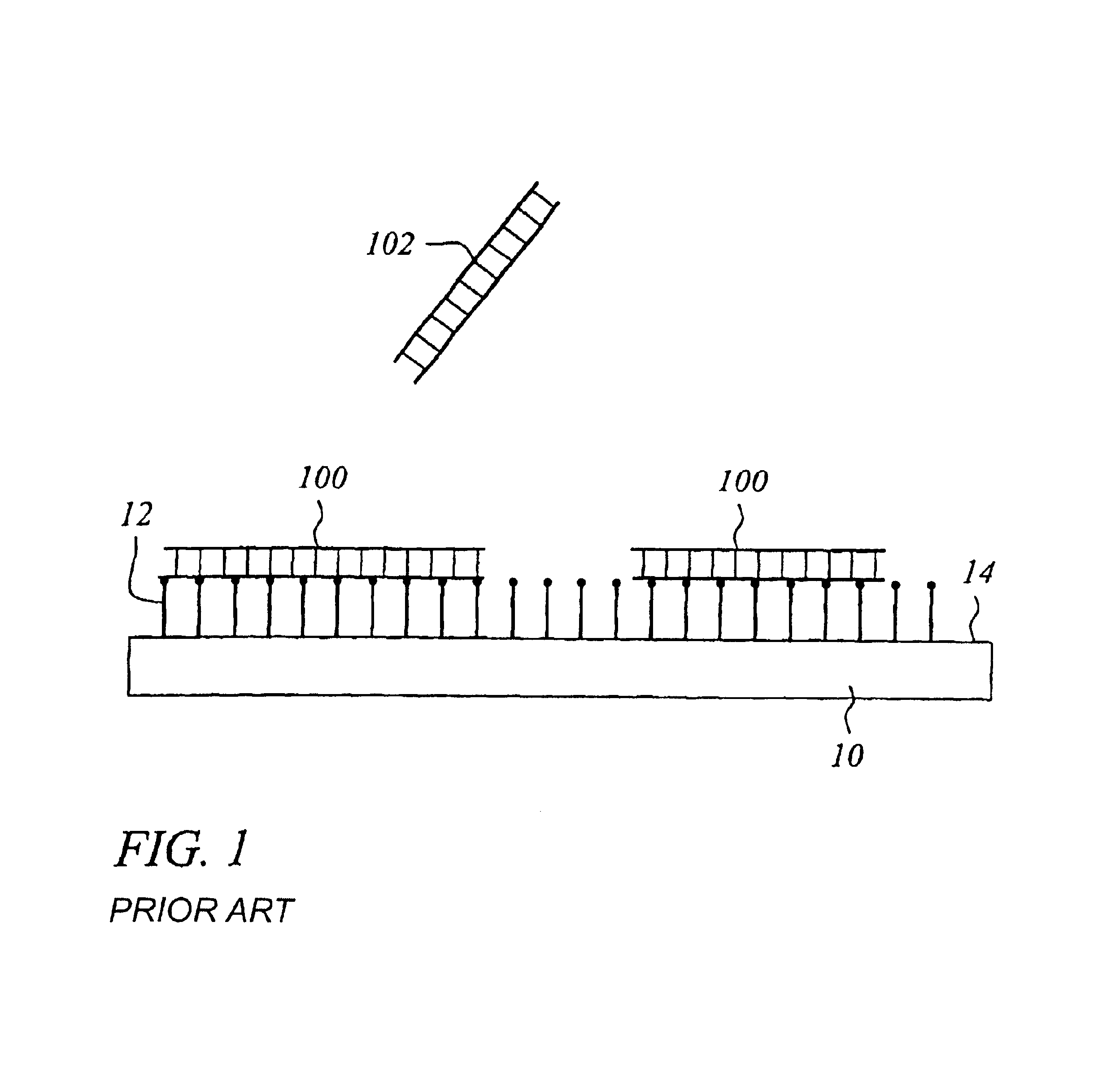Surface with tethered polymeric species for binding biomolecules
a biomolecule and polymer technology, applied in the field of surface for adsorption of biomolecules, can solve the problems of inability to produce low-cost hybridization, significant reduction in mobility, and inability to attach exogenous end attachment techniques,
- Summary
- Abstract
- Description
- Claims
- Application Information
AI Technical Summary
Problems solved by technology
Method used
Image
Examples
example 1
Body Attachment Derivatization of Amine Containing Surface Coatings with Reactive Polymer
[0052]In a clean dry glass reaction vessel 20 g 25% poly(methacryloyl chloride) in dioxane was dissolved in 200 ml anhydrous THF. To the resulting solution was added the substrate coating coated with amine surface functional groups, i.e. amino propyl triethoxy silane coated glass slides. The reaction with the polymer was carried out in a desiccator at room temperature for one hour. Because the acryloyl chloride functional group is not stable under ambient conditions further reaction with a protecting group (NHS, carbonyl imidazole (CI), . . . ) is desirable when the desired probe biomolecule will not be adhered to the surface immediately. Example utilizing NHS: After above reaction the slides are transferred to a fresh solution of 25 g N-hydroxy succinimide in 200 ml dimethyl formamide. The reaction is carried out under anhydrous conditions as above overnight with stirring. Slides are rinsed wit...
example 2
Cross-Linking of Surface Adsorbed Polymer Containing Functional Groups, Provides a Covalent Linkage to the Surface for the Adsorbed Polymer
[0054]In a clean dry reaction vessel was dissolved 7.9 g 3-(triethoxysilyl)propyl succinic anhydride (SAPTES) in 140 ml 1-methyl-2-pyrrolidinone, and 10.7 ml 1M sodium borate buffer at pH 8. Slides coated with adsorbed amine containing polymer (poly acrylamide, poly(3-aminopropylmethyl)siloxane, poly-L-lysine, and the like . . . ) were washed with 50 mM NaOH for 30 seconds and then immediately transferred to the above solution for 30 minutes with stirring at room temperature. Slides were rinsed with DI water for ten minutes and dried by dipping in ethanol for 1 minute followed by a dry nitrogen stream or spin drying. Slides are stored in a desiccator until ready to use to prevent degradation of films.
[0055]FIG. 4B shows a further embodiment of the present invention. A polymer such as polylysine or similarly charged material is attached to substra...
example 3
Reaction of Monomer Units with Surface to Provide Oligomeric Base Materials
[0056]The initial surface must have a functional group that is either a leaving group or an initiator. This example will utilize a leaving group to initiate a surface reaction, however this would be the same with an initiating group (tertiary benzyl alcohols, hydrazides, peroxides are typical). In a clean dry reactor was added 200 ml dry THF and ˜1 g NaH 24 g (60% suspension in toluene), this was stirred to form a suspension. To this was added a 5× excess (25 g) tetraethylene glycol 194 to form an alkoxide substantially on one end of the tetraethylene glycol molecule. To this solution was added bromosilane coated glass slides followed by stirring at room temperature for two hours. Slides were removed and rinsed with copious amounts of water to remove residual base. This was followed by reaction with 200 ml DMF containing 2 mM carbonyldiimidazole 162 to form an ester which reacts with amines, such as triethyle...
PUM
| Property | Measurement | Unit |
|---|---|---|
| molecular weight | aaaaa | aaaaa |
| pH | aaaaa | aaaaa |
| flexibility | aaaaa | aaaaa |
Abstract
Description
Claims
Application Information
 Login to View More
Login to View More - R&D
- Intellectual Property
- Life Sciences
- Materials
- Tech Scout
- Unparalleled Data Quality
- Higher Quality Content
- 60% Fewer Hallucinations
Browse by: Latest US Patents, China's latest patents, Technical Efficacy Thesaurus, Application Domain, Technology Topic, Popular Technical Reports.
© 2025 PatSnap. All rights reserved.Legal|Privacy policy|Modern Slavery Act Transparency Statement|Sitemap|About US| Contact US: help@patsnap.com



